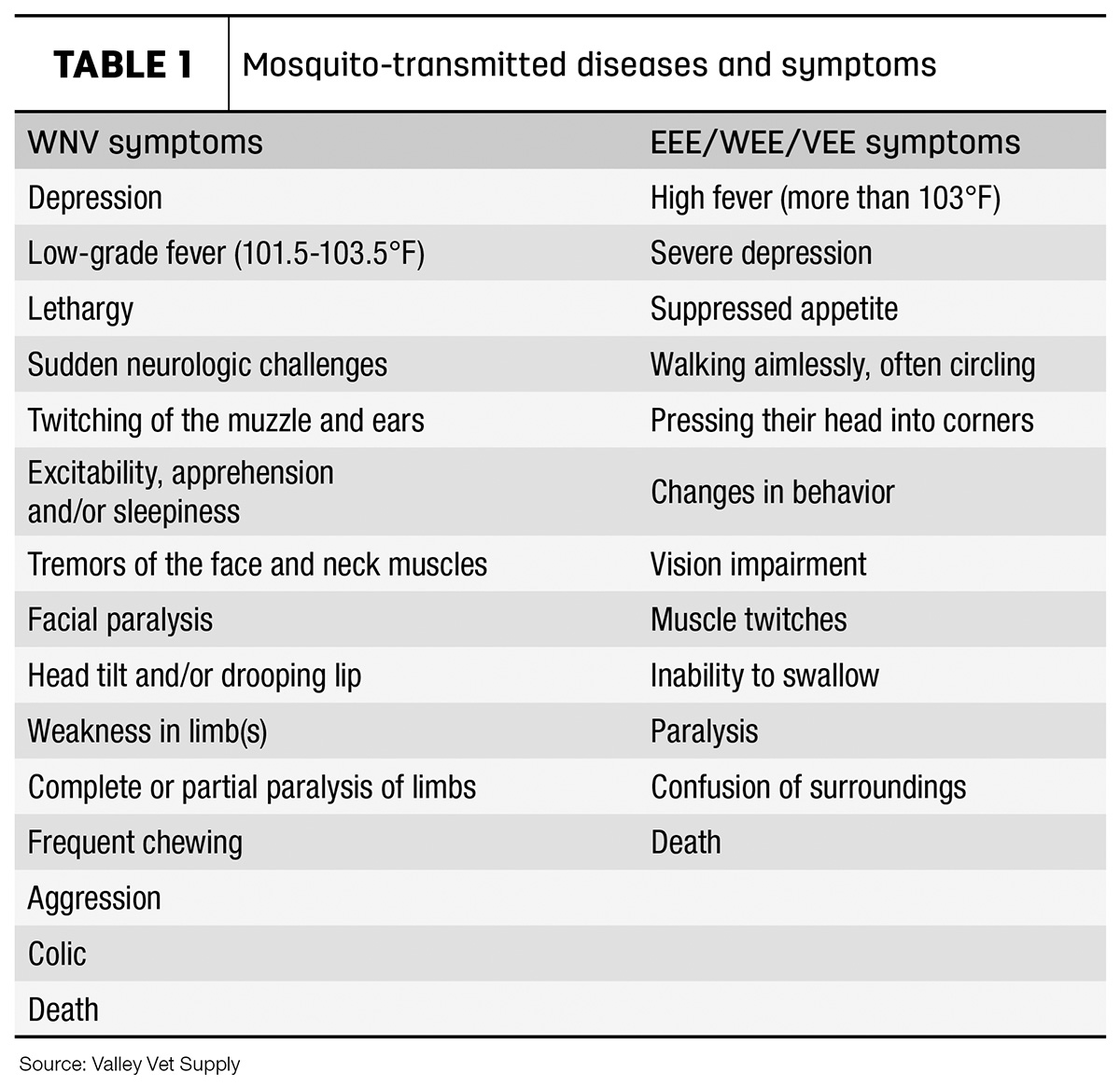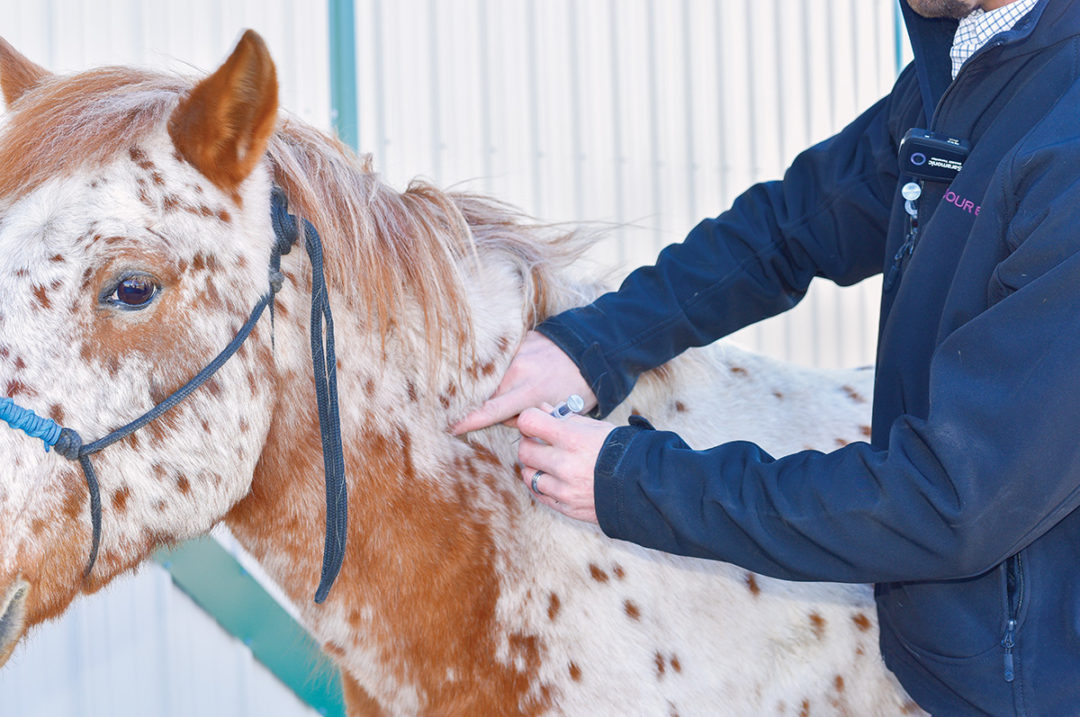It was early in the mosquito season when a young cutting horse, who had just started training, became inflicted with West Nile virus (WNV).
“The horse didn’t know where he was placing his feet, and his gait was off. When the bloodwork came back, it ended up being West Nile,” says Tony Hawkins, Valley Vet Supply technical service veterinarian. “It’s such an easy disease to prevent – as long as the horse is properly vaccinated, you don’t get any breakthrough infections.”
With about 10 weeks of treatment, the gelding survived and made a full recovery, which can be rare.
“Not many horses will recover fully. While the survival rate is high [67%], there can be some lasting side effects,” says Hawkins.
Since 1999, more than 25,000 cases of WNV encephalitis have been reported in U.S. horses, according to the American Association of Equine Practitioners (AAEP). Even more, horses represent 96.9% of all reported non-human mammalian cases of WNV disease.
“The three big core equine diseases transmitted by mosquitoes are West Nile virus, Eastern equine encephalomyelitis (EEE) and Western equine encephalomyelitis (WEE). Venezuelan equine encephalomyelitis (VEE) isn’t typically a problem, but there have been years with outbreaks in specific areas,” warns Hawkins.
These diseases can attack and inflame a horse’s nervous system – beware the wide range of symptoms a horse can demonstrate (Table 1).

The buzz about disease transmission
EEE, WEE and VEE are spread to horses by mosquitoes, which feed on infected birds and rodents that serve as the virus reservoirs. WNV is transmitted by mosquitoes, which feed on infected birds.
Justin Talley, department head for entomology and plant pathology at Oklahoma State University – who previously worked as a livestock entomologist – explains more.
“Basically, when we talk about West Nile virus, we’re talking about the culex mosquito, which was introduced into the U.S. from the Old World during the start of global trade,” says Talley. “Since then, the culex mosquito has adapted well. The biggest challenge is that in addition to feeding on horses, they are also feeding on birds, which is why they’re so good at transmitting the virus into the horse and human population, making them the dead-end host. Once the virus gets into either a horse or human, it doesn’t get into another person.”
As far as seasonality goes, Talley says you’ll generally see more mosquitoes in late summer or in the fall. The number of cases year to year is unpredictable and will vary, depending on the bird population. The disease cycle is dependent on that bird-mosquito relationship.
“It’s a cyclical pattern,” Talley says. “There’s a multitude of birds that can host West Nile virus, and when more birds come around is generally when we start seeing active infections. The mosquitoes feed on the birds that have that infection, and an incubation period goes through the mosquito. Then the mosquito becomes the active vector which can transmit West Nile virus into the horse.”
The virus has been documented throughout the continental U.S., as well as Mexico and Canada – thus, all horses are at risk if they are unprotected.
Shield horses from harm
Moving air plays an important part in mosquito control. “Mosquitoes are weak fliers; they can’t fly through moving air,” says Hawkins. “As much moving air as you can design into your barn and your horses' stalls will be helpful in preventing them from landing and taking a blood meal from your horse. For barn fire prevention, be sure you’re using a livestock fan with an enclosed, protected motor instead of a box fan. A true livestock fan will also move more air, deterring mosquitoes – and flies, too.”
In addition to moving air, never underestimate the importance of vaccinations and good barnkeeping. “It’s important to stay on top of your West Nile virus vaccine and boosters,” Talley says, also recommending that horse owners eliminate standing water to deter mosquito breeding habitats, as well as regularly clean water troughs.
Horses are continually exposed to the environment, wildlife and mosquitoes that transmit the five core equine diseases.
“It is important to follow the AAEP core equine disease vaccination protocol,” says Hawkins. “Make sure horses are vaccinated yearly against Eastern and Western equine encephalomyelitis, West Nile virus, rabies and tetanus.”
Risks posed to people, pets and livestock
Of course, horses aren’t the only ones at risk from mosquitoes and diseases they transmit. Mosquito-transmitted diseases such as West Nile virus, malaria and Zika virus can affect people. Pets are also at significant risk for heartworm disease, which is transmitted by mosquitoes and prevented by nearly 100% when a pet is on monthly heartworm prevention. When faced with large populations of mosquitoes, livestock can be plagued with extensive blood loss, reduced productivity and even death. Pour-on solutions are available that target mosquitoes, as well as lice and a number of fly species, including horn flies, face flies, horse flies and more.
Considering that 1 acre of land can house 1 million mosquito eggs, it is important to help eliminate the mosquito population by removing mosquito-breeding habitats, such as anything that can hold water, like unused troughs, tarps and wheelbarrows. If your yard or barn area has any low-lying areas that collect water after rainfall, be sure to fill these in.
For your horses and livestock, hang fans to keep mosquitoes out of your barns. You also can deploy proven mosquito prevention products to do all that you can to control them and the risks they can pose to your family and animals.









